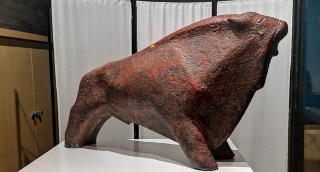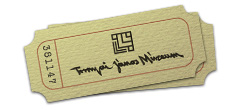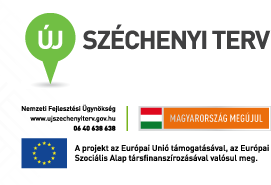JÁNOS TORNYAI MUSEUM
The possibility of founding the JÁNOS TORNYAI museum in Hódmezővásárhely was created by the industrial and agricultural exhibitions of 1904. Following Tornyai’s proposal, the organizers decided to add a “chat room” to the exhibition, where art and ethnographic objects could be seen by the visitors.
The material collected under the guidance of the painter was conducted by the renowned ethnographer, Lajos Kiss. Painted furniture, embroidery, ceramics and guild commemoratives were gathered thanks to 159 persons.
Due to the expressed opinion of nationally recognized experts and local artists, following the close of the exhibition, the city’s leaders kept the material together, calling for the establishment of a local museum.
Unfortunately, only seven out of the 159 exhibitors allowed the future museum to retain their ethnographic objects. So the City Council appointed Lajos Kiss to collect material on behalf of the museum. Over one year Kiss collected more than 600 objects. These were placed in the barracks, in János Tornyai's apartment. The City Council made its decision on the matter of founding a museum on the 15th February 1905. That date is considered to be the birthday of the museum.
According to the nature of the collection, the museum of Hódmezővásárhely was initially called Museum of Ethnography. In 1906 János Tornyai enriched the museum by his own 252-piece collection of ethnographic material.
In 1907 the city rented three rooms for the museum. These were filled with nearly a thousand objects arranged by Lajos Kiss, and on the 20th October the museum was opened to the public.
Significant change occurred in the history of the museum in 1914, when on government money (65,000 crowns), the city bought dr. Imre József's one-storey house located on the József Ferenc Avenue 14. (now Dr. András Rapcsák Street 16.) for the rather neglected museum collections and public libraries. However this was still not considered as a permanent solution, for several other institutions were operating in the building, and a part of it was inhabited by tenants. In addition the planned changes could not be executed due to the war.
Meaningful change in the fate of the collection - professional processing, presentation - has not occurred until 1928, when Károly Cs. Sebestyén organized an exhibition of the museum’s material.
The museum's own archaeological activities started in 1929 when János Banner - Professor at the University of Szeged - initiated excavations on the outskirts of the town. His excavation on Kökénydomb opened up such a rich and important Neolithic site, that it provided material basis for a whole archaeological department. The restored findings were exhibited the following year.
While the development of the ethnographic collection stagnated during this period, thanks to the hard work of János Banner, the archaeological collection has witnessed a spectacular grow, and gained a considerable reputation among foreign researchers, marked by Gordon Childe's visit in 1938.
The first publication of the museum is linked to archaeology as well. In 1940, János Banner published the first part of his huge monograph entitled History of Hódmezővásárhely till the Age of the Hungarian Settlement: From the Earliest Times to the Bronze Age.
The art collection of the museum was founded by the legacy of János Tornyai in 1936. The painter died on the 26th September 1936, and before his death, by a gift agreement, he donated a large part of his works – 923 pieces - to the city.
The museum became independent after the Second World War, taking control of its budget and staff in 1946. Dr. Miklós Galyasi was appointed director of the museum. His colourful personality induced a vibrant cultural life in the museum, which attracted many students of the College of Fine Arts who were on artist practice, like József Németh, Gyula Kajári, Ferenc Szalay, and others, to settle there definitively.
After a series of relocations, the museum finally got back the János Szántó Kovács Street building, and it also received the adjacent building, after its nationalization. In 1949 the archaeological exhibition entitled From the Neolithic till the Hungarian Settlement was completed, and then opened by Gyula Ortutay.
In 1951 the institution took up the name János Tornyai, and from this time on, its main profile has become fine arts. There being no art gallery in the city, the museum turned into a fine art center. In 1954 the museum opened its first Autumn Exhibition at Hódmezővásárhely, which is still the institution’s most attended temporary exhibition of national importance on a yearly basis. In the last decades the museum’s fine arts collection was enriched mainly by purchasing works presented at this exhibition. The same year saw the opening of the museum's permanent exhibition of folk art.
The recording of the local historical materials was launched in 1963. The collection’s guild commemoratives are of outstanding significance.
Another archaeological exhibition was opened in 1969, entitled Art of the Neolithic and Bronze Age, where such world-famous artifacts were presented as Kökénydomb Venus, Kökénydomb Altar, Szegvár-Tűzköves God with Sickle. This exhibition was open for the public for more than thirty years, then, it was renewed in 2005 with the title Weekdays’ Venuses. Since 1990 a small ethnographic exhibition gives a good sample of the folk art of Hódmezővásárhely.
The photo collection includes 1,615 outstanding shots of folklore and local history moments captured on glass plates, which were produced by photographer József Plohn around the turn of the 19th and 20th centuries.
The museum owns 73,000 archaeological, nearly 9,000 ethnographical, 8,500 local historical, and 3,700 art objects.
| Tornyai János Múzeum | |
| 6800 Hódmezővásárhely, Dr. Rapcsák András út 16-18. | |
| Telefon: | +36 62 242 224 |
| E-mail: | tjm@tjm.hu |
| Térkép: |  |




